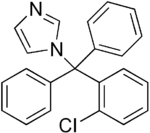Difference between revisions of "Clotrimazole"
(→Notes) |
(→Notes) |
||
| Line 19: | Line 19: | ||
Approximately 10 tonnes are produced in the EU each year, and almost the same quantity is imported. The main potential source of clotrimazole to the environment comes from discharges from municipal waste water treatment plants as a result of waste water from households.<ref name = OECD>[http://www.ospar.org/documents%5Cdbase%5Cpublications%5Cp00199_BD%20on%20clotrimazole.pdf OSPAR Commission, 2005: OSPAR background document on clotrimazole]</ref> | Approximately 10 tonnes are produced in the EU each year, and almost the same quantity is imported. The main potential source of clotrimazole to the environment comes from discharges from municipal waste water treatment plants as a result of waste water from households.<ref name = OECD>[http://www.ospar.org/documents%5Cdbase%5Cpublications%5Cp00199_BD%20on%20clotrimazole.pdf OSPAR Commission, 2005: OSPAR background document on clotrimazole]</ref> | ||
| − | Clotrimazole has a low water solubility | + | Clotrimazole has a low water solubility (0,49 mg/l). It is considered a persistent substance which shows little or no biodegradability and has a low to moderate tendency to [[bioaccumulation|bioacumulate]]. |
| + | |||
| + | It is a toxic substance for aquatic organisms. Concentrations of only 0,02 mg/l have lethal effects on crustaceans. Fish can tolerate concentrations up to 0,29 mg/l. However prolonged exposure to concentrations of 0,025 mg/l might already cause effects on the fish. In rats doses up to 50 mg per kg body weight were necessary to cause a reduced survival rate of pups. <ref name = OECD>[http://www.ospar.org/documents%5Cdbase%5Cpublications%5Cp00199_BD%20on%20clotrimazole.pdf OSPAR Commission, 2005: OSPAR background document on clotrimazole]</ref> Microalgal communities might however be extremely sensitive to the substance. Concentrations as low as 17 ng/l might already result in adverse effects on the algae, although concentrations above 3,5 µg/l are necessary to cause visual effects on community growth. <ref>[http://cat.inist.fr/?aModele=afficheN&cpsidt=21146400 Porsbring Tobias; Blanck Hans; Tjellström Henrik; Backhaus Thomas 2009, Toxicity of the pharmaceutical clotrimazole to marine microalgal communities. Aquatic toxicology (Amsterdam, Netherlands) 2009;91(3):203-11.]</ref> | ||
The highest concentrations measured in [[estuary|estuaries]] is 22 ng/l, the median measured concentration in estuaries is 7ng/l. | The highest concentrations measured in [[estuary|estuaries]] is 22 ng/l, the median measured concentration in estuaries is 7ng/l. | ||
Revision as of 11:51, 27 August 2009
Definition of clotrimazole:
Clotrimazole is a pharmaceutical. It's mainly used to treat dermatological and gynaecological fungal infections.[1]
This is the common definition for clotrimazole, other definitions can be discussed in the article
|
Notes
| Clotrimazole |
|---|

|
| Formula |
| C22H17ClN2 |
Approximately 10 tonnes are produced in the EU each year, and almost the same quantity is imported. The main potential source of clotrimazole to the environment comes from discharges from municipal waste water treatment plants as a result of waste water from households.[1]
Clotrimazole has a low water solubility (0,49 mg/l). It is considered a persistent substance which shows little or no biodegradability and has a low to moderate tendency to bioacumulate.
It is a toxic substance for aquatic organisms. Concentrations of only 0,02 mg/l have lethal effects on crustaceans. Fish can tolerate concentrations up to 0,29 mg/l. However prolonged exposure to concentrations of 0,025 mg/l might already cause effects on the fish. In rats doses up to 50 mg per kg body weight were necessary to cause a reduced survival rate of pups. [1] Microalgal communities might however be extremely sensitive to the substance. Concentrations as low as 17 ng/l might already result in adverse effects on the algae, although concentrations above 3,5 µg/l are necessary to cause visual effects on community growth. [2]
The highest concentrations measured in estuaries is 22 ng/l, the median measured concentration in estuaries is 7ng/l.
In 2005 OSPAR considered it unnecessary to propose measures for the reduction of discharges of clotrimazole.[1]
Environmental standards and legislation
Included in the OSPAR list of substances of priority action
See also
OSPAR background document on clotrimazole